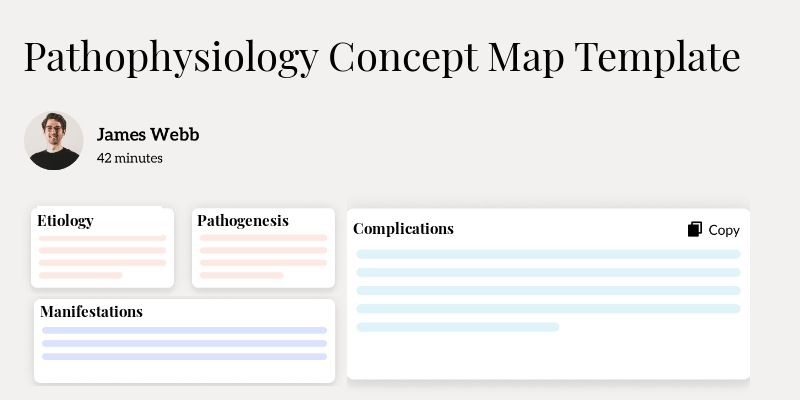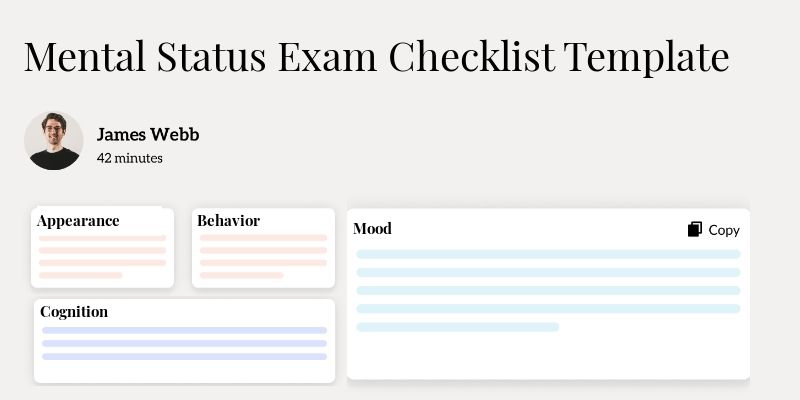
Pathophysiology Concept Map Template
Hey there! Ever found yourself tangled up trying to put together a pathophysiology concept map? It's one of those tasks that can feel overwhelming as the information sprawls across multiple subjects. Having the right template can turn chaos into clarity, making your work not just manageable, but insightful. Let's get you feeling confident about using pathophysiology concept map templates!
What Is a Pathophysiology Concept Map Template?
A pathophysiology concept map template is a structured framework used to visualize the various interconnections and processes associated with a disease. It typically helps medical professionals and students to organize and synthesize complex information, leading to better understanding and retention.
By laying out information in a visual format, these templates aid in recognizing the underlying causes, interactions, and effects of pathological processes. This method of documentation is not only useful in learning environments but also instrumental in clinical practice.
Key Components of a Pathophysiology Concept Map?
The main elements of a pathophysiology concept map include:
- Central Condition: The main disease or disorder being detailed.
- Pathophysiological Processes: Sub-categories outlining different physiological dysfunctions.
- Etiology: Underlying causes of the condition.
- Clinical Manifestations: Symptoms resulting from the condition.
- Treatment Options: Potential interventions and management strategies.

How to Use a Pathophysiology Concept Map Template: Step-by-Step Process
Step 1: Identify the Central Condition
Clearly define the central disease or disorder you need to map out.
Step 2: Research Thoroughly
Gather detailed information on the pathophysiology, symptoms, and treatments available for the condition.
Step 3: Draft Initial Map
Begin by plotting a rough sketch of your concept map, focusing on major pathways and interactions.
Step 4: Finalize the Structure
Refine the map by adding missing details, removing redundancies, and ensuring clarity.
Step 5: Review and Update
Regularly revisit the map to add new scientific discoveries or treatment methods.
Benefits of a Pathophysiology Concept Map
Benefit | Explanation |
|---|---|
Enhanced Understanding | Visual representation improves comprehension of complex pathophysiological processes. |
Efficient Learning | Aids in quicker assimilation and recall of information. |
Interdisciplinary Communication | Facilitates easier sharing and understanding across diverse medical fields. |
Clinical Application | Assists healthcare providers in correlating symptoms with the underlying pathology. |
Stakeholders in Pathophysiology Concept Map
Several key players benefit from the use of pathophysiology concept maps:
- Medical Students: Jane, a medical student, uses concept maps to link classroom theory to clinical practice.
- Medical Educators: Dr. Smith, an anatomy professor, employs concept maps for teaching complex cardiovascular disorders.
- Healthcare Providers: Nurse Lucas integrates concept maps into patient education to simplify explanations of chronic illnesses.
Example of a Pathophysiology Concept Map PDF
You can find an illustrative PDF of a pathophysiology concept map of myocardial infarction by clicking the link below.
Real-World Use Cases: Practical Impact of the Pathophysiology Concept Map Template
Concept maps have real‑world impacts that extend beyond theoretical knowledge:
- Mary, a resident, crafts detailed concept maps that help her team prepare for case presentations on unusual respiratory diseases.
- In pediatric units, nurses use concept maps to identify potential complications from asthma and preemptively manage them.
- For cardiovascular discussions, surgeons illustrate complex surgeries and interventions with maps to align teams on the procedure.
Conclusion
Pathophysiology concept maps bridge the gap between theory and practical medical understanding. From simplifying the complexities of disease mechanisms to enhancing communication among medical staff, their benefits are profound and wide‑ranging. Whether you're a student building foundational knowledge or a professional refining your clinical insights, these templates are an invaluable part of your toolkit.
Disclaimer: This article is for informational purposes only and does not constitute legal or medical advice. Always consult professional guidelines and regulatory bodies for specific compliance requirements.

Dr. Danni Steimberg
Dr. Danni Steimberg is a pediatrician at Schneider Children’s Medical Center with extensive experience in patient care, medical education, and healthcare innovation. He earned his MD from Semmelweis University and has worked at Kaplan Medical Center and Sheba Medical Center.
Great maps don’t just define a disease ‑ they show how a cause becomes a symptom and then a treatment plan. The CASCADE‑3T flow ‑ Cause, Cascade, Clinical signs, Tests, Targets, Traps ‑ forces a clean line from mechanism to bedside action.
- Draw the chain: Start with the trigger, map 3-5 mechanistic steps (mediators, cellular effects, organ dysfunction), and end with the top clinical manifestations using simple arrows and action verbs.
- Link signs to tests: For every manifestation, pair the confirming test or biomarker and the mechanism it reflects (example: RAAS activation -> aldosterone -> hypokalemia -> EKG U waves).
- Place therapy at leverage points: Drop treatments exactly where they interrupt the chain - trigger removal, pathway block, symptom control - and add one trap per therapy (contraindications or pitfalls) so the plan is audit-proof and safe.
Frequently Asked Questions
Reduce burnout,
improve patient care.
Join thousands of clinicians already using AI to become more efficient.

Mental Status Exam Checklist Template
Discover practical Mental Status Exam Checklist Template templates to enhance your documentation efficiency.

Family Therapy Note Template
Discover practical Family Therapy Note templates to enhance your documentation efficiency.

Patient Education Handout Template
Discover practical Patient Education Handout Template templates to enhance your documentation efficiency.

